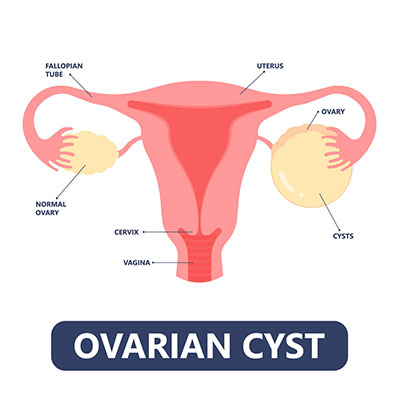
Overview
Ovarian cyst is the growth of fluid-filled sacs inside one or both ovaries, and/or on the surfaces of the ovaries. The ovary are the female reproductive organ that produce and develop the egg cells also known as ova or oocytes.
Most ovarian cysts are harmless, frequently exhibit no symptoms, and will eventually regress even without treatment. However, ovarian cysts have the potential to twist or rupture which could result in life-threatening complications if left untreated.
A routine screening of pelvic exam may help to detect and reduce risk of ovarian cysts before they cause symptoms. Treatment options of ovarian cyst are watchful waiting, medication, and surgery.
Types of ovarian cyst
Functional cysts
Functional cysts (also called simple cysts) caused by a normal monthly function of the ovary. These cysts are usually harmless, rarely cause pain and often disappear within 2-3 menstrual cycles.
- Follicular cysts: Ovarian follicles are sacs that contain egg cells (ova), which are released during ovulation. A follicular cyst becomes cystic when it fails to release an egg and persists on the ovary.
- Corpus luteum cysts: After ovulation, the remaining follicle becomes the corpus luteum that produce estrogen and progesterone. When fluid builds up in the corpus luteum, it grows and creates a cyst.
Other cysts
Other types of ovarian cyst that are not related to the menstrual cycle.
- Cystadenomas: These cysts develop on the ovary’s surface. They may be filled with thin, watery fluid or thicker, mucous-like fluid.
- Dermoid cysts (teratomas): These cysts develop from embryonic cells, and as a result, they can contain tissue like hair, skin, or teeth.
- Endometriomas: Ovarian endometrioma is a cystic mass which develops from endometrial tissue (tissue that lines the uterus) within the ovary.
Symptoms
Most cysts are harmless and dissolve on their own, but the following symptoms are cause by large ovarian cyst.
- Abdominal or pelvic pain
- Dyspareunia – painful intercourse
- Fullness or heaviness at the lower abdomen
- Bloating
Seek immediate medical care if you experience
- Sudden or severe abdominal or pelvic pain
- Pain accompanied by fever or vomiting
- Fast breathing or lightheaded or weakness
Causes
The primary cause of ovarian cysts is ovulation. Additional factors include:
- Reproduction of abnormal cells: Dermoid and cystadenomas are examples of cysts that can develop due to atypical cell reproduction.
- Endometriosis: The cysts may form on the ovaries due to spreading of pelvis endometriosis.
- Pelvic inflammatory disease(PID):Cysts can form when severe pelvic infections spread to your ovaries.
Risk factors
Chances of developing an ovarian cyst are increased by:
- Age: It is common to have ovarian cysts if someone haven’t had menopause.
- Pregnancy: the cyst remains on the ovary throughout the pregnancy.
- Pelvic infection: Cysts may develop if the infection spreads to the ovaries.
- History of ovarian cyst: If you’ve ever had an ovarian cyst, it is more likely to develop another ovarian cyst.
- Endometriosis: Uterine endometrial cells develop outside of your uterus. As a result of this illness, some of the tissue has the potential to develop onto the ovary.
Diagnosis
Following tests to diagnose an ovarian cyst:
- Pelvic examination: a cyst on the ovary may be discovered by the specialist during pelvic examination.
- Pregnancy test: A corpus luteum cyst can cause a false positive on a urine pregnancy test.
- Pelvic ultrasound: imaging method, sound waves are used to produce images of the internal organs in the body. It can locate and determine the predominant fluid or solid nature of cysts at the ovaries.
- Laparoscopy: Using a laparoscope, specialist will use a tiny incision to put a thin, illuminated tool into the abdomen so they can observe both ovaries and remove the ovarian cyst. Anesthesia is necessary because this is a surgical operation.
- Tumor marker test: Women with ovarian cancer frequently have higher blood levels of a protein known as cancer antigen 125 (CA 125). This test may be prescribed by the doctor if the cyst is partially solid and have a high risk of developing ovarian cancer. In noncancerous disorders such endometriosis, uterine fibroids, and pelvic inflammatory disease, elevated CA 125 levels can also develop.
Treatment
Treatment will be based on the age, the type of cyst, size, and symptoms. Specialist might advise:
- Watchful waiting: Usually, functional ovarian cysts disappear on their own. If the cyst is probably functional cyst, specialist may advise waiting it out a few weeks or months following the diagnosis, patient might have a follow-up pelvic ultrasound to see if the cyst has cleared up on its own.
- Medication: Hormonal contraceptive such as birth control pills can be effective in preventing ovarian cyst from forming, however, if a cyst already exists, taking a birth control pill will not help reducing the size.
- Surgery: specialist may advise the patient to have the cyst removed if it is large, does not appear to be a functional cyst, continually growing, persists for two or three menstrual cycles, or it causes pain.
- Cystectomy: It is possible to treat certain cysts without removing the ovary by performing ovarian cystectomy.
- Oophorectomy: Specialist may recommend removing the affected ovary in some circumstances while leaving the other one unaffected by oophorectomy.
- Total hysterectomy with oophorectomy: In case that the cyst is cancerous, total hysterectomy is needed, it is the removal of the uterus, ovaries, and the fallopian tubes especially when the cyst develop after menopausal.





